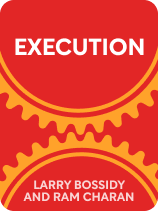

This article is an excerpt from the Shortform book guide to "Execution" by Larry Bossidy and Ram Charan. Shortform has the world's best summaries and analyses of books you should be reading.
Like this article? Sign up for a free trial here .
What is a tactical business plan? How can a tactical plan help you turn your business goals into reality?
Identifying your business goals is important, but it doesn’t mean anything if you don’t have a plan to execute those goals. In their book Execution, business leaders Larry Bossidy and Ram Charan teach you how to make a tactical plan to bring your business goals to fruition.
Here’s how to create a tactical business plan.
Create Tactical Plans That Work
In this article, you’ll learn how to translate your business strategy into reality using a tactical business plan. We’ll discuss the factors that make a tactical plan work well and the basic steps to follow when putting it together.
The Key Elements of a Tactical Plan
Your tactical business plan specifies both short-term and long-term goals aligned with your strategy and describes how you’re going to reach those targets. Bossidy and Charan explain that it includes the major programs and projects that are lined up for the coming year, such as a new marketing initiative, a product release, or a sales force reconfiguration.
(Shortform note: Whereas Bossidy and Charan speak of tactical plans generally, some people distinguish between two main types of tactical plans. A single-use plan is designed for a special project that’s not likely to be repeated, whereas a standing plan is used multiple times for projects that occur regularly.)
There is no strict formula for creating a tactical plan. It requires deep engagement, rigorous truth-telling, critical thinking, and much give-and-take between team members. That said, the general flow in creating your tactical plan, according to Bossidy and Charan, is fairly straightforward. Implement the following steps to create a plan that is ambitious and realistic—and that facilitates learning and relationship-building with key players in your company:
Step #1: Give leaders from each segment of the company the big-picture targets (for example, revenue and operating margin). Then, let each leader develop a tactical plan for their particular division to help the company reach those targets.
Step #2: Convene everyone to stress-test the assumptions built into each plan. For example, if you increase prices, will it turn customers away? Is demand for this product merely a short-term trend, or is it worth additional investment? The authors instruct that you—as the leader—must engage everyone by asking pointed questions to determine what’s most likely to produce the intended outcomes.
Step #3: Revisit and adjust plans based on how they fit with every other part of the company. Bossidy and Charan explain that everyone must constantly assess what give-and-take is necessary in the pursuit of big-picture goals. Devoting attention and resources to one opportunity or business unit inevitably comes at the expense of another. For instance, if you allocate additional resources to your European market, then you need to cut expenses elsewhere. Does it make more sense to do that in your North American market or your Asian market? After this vigorous back-and-forth discussion among the key players, the basic tactical plan is set.
(Shortform note: Although some give-and-take is inevitable when creating a tactical plan, as when a company must choose how to allocate limited financial resources, recent developments have made some trade-offs less significant. For example, Just-in-Time production—a method in which a company produces just enough goods, precisely when customers require them—can help reduce lead times while also sustaining high quality, thereby reducing the usual trade-off between efficiency and quality.)
Step #4: Identify contingency plans that can accommodate shifting circumstances. For example, if the European market goes cold, you’ll need to make up that anticipated revenue another way. Where will it come from? Robust contingency plans, Bossidy and Charan contend, can accelerate decision making and help you avoid costly delays.
Step #5: Wrap up discussion and secure commitments from everyone to ensure alignment with the tactical business plan.
Step #6: Follow up after the meeting with the key players, just as with the strategic plan. The authors recommend sending a memo that summarizes each person’s commitments and short-term benchmarks.
Step #7: Assess progress toward those benchmarks at quarterly review meetings.
| Tools and Techniques for Stellar Tactical Planning and Follow-Through Bossidy and Charan provide a solid basic framework for tactical planning, but they don’t provide more specific guidance on how to implement each step. The following suggestions can help you navigate the planning process smoothly: Consider hiring an external facilitator to help your leaders create their segment’s plan. This offers many benefits, such as a more objective outsider perspective. Look into project management software to help you plan projects, assign tasks and due dates, track progress toward agreed benchmarks, and make timely adjustments. Digital solutions like this can help you cut down on lags in communication by enabling all the people involved in a project to see what everyone else is doing, as well as what next steps are needed and when. Use creative ideation techniques to bring hidden assumptions to the surface. People tend to take for granted that things must be a certain way, especially if they’ve been in the same role or industry for a long time. They may, for example, assume that television advertising will produce the best customer response to a product upgrade because that’s what has worked for years. But what if there’s actually a better marketing approach? Blasting through faulty assumptions can bring forward innovative ideas to take your company to a new level. One technique for highlighting assumptions is Worst Possible Idea, which involves team members intentionally bringing forward the worst solutions for problems facing the company. This helps people relax so they’re more likely to think creatively. Create visual models like mind maps, risk probability matrices, and flow charts when discussing contingency plans. This organizes and categorizes information clearly, which supports participants in comprehending, evaluating, and prioritizing risks that could jeopardize your company. Foster psychological safety in your follow-ups. This means ensuring people feel secure, valued, and safe to speak up in the workplace, even when they disagree with you or the rest of the team. Rather than simply detailing agreed-upon commitments, make an effort to create psychological safety by affirming people’s roles and contributions to the company and acknowledging them for sharing new ideas among your team. This is especially important in times of uncertainty. Thoughtfully plan and coordinate quarterly reviews to get maximum value from the meetings. Proper preparation includes scheduling the review well in advance, having a pre-meeting briefing, and creating an agenda. Topics should include identifying lessons learned and ways to apply those lessons to future activities. Participants should leave with clarity about the previous quarter’s successes and failures and what factors influenced those results—as well as confidence about achieving benchmarks for the coming quarter. |

———End of Preview———
Like what you just read? Read the rest of the world's best book summary and analysis of Larry Bossidy and Ram Charan's "Execution" at Shortform .
Here's what you'll find in our full Execution summary :
- What execution in business is and why it matters
- The three core functions that leaders must perform to execute well
- The three important qualities leaders must have to execute well







Hey there, Shortform Blog team! 👋 I just finished reading your article on creating a tactical business plan, and I must say, it’s an absolute gem for entrepreneurs and business enthusiasts like myself. Your concise yet comprehensive guide provided practical insights that are crucial for anyone looking to develop a solid roadmap for their business.
I really appreciate how you emphasized the importance of aligning strategy with action. Your step-by-step breakdown of the tactical business planning process was incredibly helpful in understanding how to translate high-level goals into actionable tasks. From defining objectives and identifying key initiatives to setting clear timelines and assigning responsibilities, your article covered all the essential elements of a well-structured business plan.
Furthermore, your emphasis on adaptability and flexibility was spot on. In today’s rapidly changing business landscape, being able to adjust and pivot is essential for long-term success. Your tips on regularly reviewing and revising the tactical plan to accommodate new information and market dynamics were invaluable. It’s clear that you understand the need for businesses to be agile and responsive in order to thrive.
Thank you for providing such valuable guidance on creating a tactical business plan. Your expertise and insights are highly appreciated, and I’m confident that many readers, myself included, will benefit greatly from your advice. Keep up the fantastic work, and I’m excited to explore more of your content in the future!